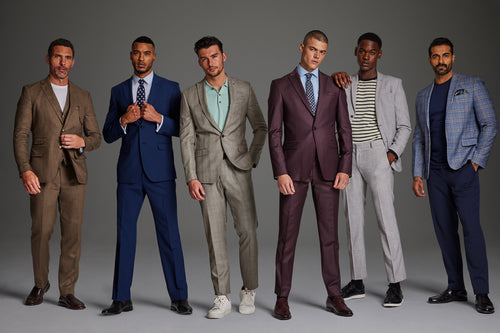-

How to Choose the Perfect Suit for Your Wedding Day?
Introduction
Your wedding day is one of the most important days of your life, and looking your absolute best is a mus...
-

Top Men's Suit Trends for Prom Season 2025
Prom night is one of the most memorable events in a young man's life, and choosing the right suit can make all the di...
-

Top Business Suit Trends for 2025: What’s In & What’s Out
Introduction:As we step into 2025, the world of business fashion is evolving like never before. The modern gentleman ...
-

Spring & Summer Suit Trends: Stay Cool & Stylish
Introduction:
As the seasons change and the temperatures rise, your wardrobe should adapt accordingly. Spring and sum...
-

Luxury Suit Brands Leading the Fashion World Right Now
Introduction
In the ever-evolving world of men’s fashion, luxury suit brands continue to set the standard for eleganc...
-

How to Wear a Suit Casually & Still Look Sharp
A well-tailored suit isn’t just for formal occasions. When styled right, you can wear a suit casually and still look ...
-

10 Must-Have Suit Styles for the Modern Gentleman
A well-tailored suit is a wardrobe essential for every modern gentleman. Whether you're dressing for a business meeti...
-

Best Suits to Wear for Weddings in 2025 – Trendy Groom & Guest Attire
Are you wondering what suit to wear for a wedding in 2025? Whether you’re the groom, best man, or a wedding guest, fi...
-

Choosing the Perfect Clothes to Wear to Homecoming This Season
Homecoming is a special time for students who love to celebrate school spirit, come together with friends, and make u...
-

Homecoming Dance Attire for Guys What to Wear for a Stylish Look
Homecoming is an unforgettable event which is held in high school. This is filled with fun, dance, and creates memori...
-

How to Choose the Right Attire for Homecoming Autumn Edition
Homecoming is an exciting time, and the perfect attire for homecoming can set the tone for a night to remember. The ...
-

Homecoming vs Prom: Key Style Differences Every Guy Should Know
High school life is a very beautiful life, but two of the most popular events are prom and homecoming. These events a...
-

Velvet Suits: The Ultimate Blend of Style and Comfort for Winter Outfits
Winter brings a unique opportunity to elevate your wardrobe with luxurious fabrics, and velvet suits stand out as a t...
-

How to Wear a 3 Piece Suit
The three-piece suits are a popular choice in formal wear. From the regal courts of Europe to the bustling streets of...
-

How to Choose the Perfect Linen Suit for the Summer
As the summer heat begins to soar, it's time to refresh your wardrobe with the perfect linen suit. While many men may...
-

How to Style a Velvet Blazer for Men
The velvet blazer, with its luxurious texture and deep, rich colors, has long been a symbol of elegance and sophistic...
-

What to Wear to a Wedding as a Guest for Male
Being a well-dressed guest is akin to a miniature wedding gift—a bit of time, effort, and sometimes expense, presente...
-

How to Wear a Suit Without a Tie
The art of wearing a suit is often associated with a sharp tie knotting up the ensemble. However, the modern sartoria...
-

What is the Best Suit for All Occasions?
Suits are very important in men's clothing. Finding the perfect suit that can seamlessly transition across all occasi...
-

How To Style A Burgundy Suit For Any Occasion
The burgundy suit, with its rich, vibrant hue, stands out as a versatile and stylish choice for a multitude of occasi...
-

Can you wear a Burgundy Suit to a Wedding
Suit are popular clothing options. When it comes to wedding attire, the traditional black tuxedo or navy suit might f...
-

What is a Mandarin Suit?
A Mandarin suit, also known as a Mao suit, is a traditional Chinese-style garment that typically consists of a close...
-

How to Choose the Right Fit Style for Men's Suits?
Suits are the popular choice in the men's clothing world. These are available in different fits and styles. However,...
-

What do Guys Wear to Homecoming?
Homecoming is an exciting event in the academic calendar, often associated with spirited football games, dazzling da...
-

Royal blue vs Navy blue Suit
Suits are popular in menswear and come in different colours, such as royal and navy blue. However, the choice of colo...
-

What is the Difference Between a Seersucker Suit and a Regular Suit?
The world of men's fashion is a vast and diverse landscape, with various suits that cater to different tastes and oc...
-

Are Pea Coats Practical for Every Occasion?
The pea coat, with its roots deeply embedded in naval history, has transcended its military origins to become a timel...
-

Ever Wondered About the History of Overcoats?
Introduction:
As temperatures drop and winter winds blow, the overcoat becomes a stalwart companion, providing both w...
-

How to Rock Men's Outerwear Like a Pro?
Outerwear is more than just a shield against the elements; it's a crucial element in crafting a polished ...
-

Leather Coats: Classic or Contemporary?
In the ever-evolving landscape of men's fashion, leather coats stand as an iconic piece that seamlessly straddles the...
-

Fur Coats for Men: Yay or Nay?
The world of men's fashion has often been a stage for sartorial experimentation and style debates. One such polarizin...
-

What Sets Car Coats Apart in Men's Fashion?
In the realm of men's fashion, certain garments stand out not only for their style but also for their unique characte...
-

Why Pea Coats Are a Winter Essential?
As winter descends and the temperatures plummet, the search for the perfect outerwear becomes paramount. Among the my...
-

Are Trench Coats Timeless or Trendy ?
In the ever-evolving realm of men's fashion, few garments have stood the test of time as gracefully as th...
-

How to Choose the Perfect Overcoat
An overcoat is more than just a piece of outerwear; it's a statement of style, sophistication, and practicality. Emen...
-

What's Trending in Men's Outerwear?
In the ever-evolving world of men's fashion, staying on top of the latest trends is essential, especially...
-

Are Dress Shirts Comfortable?
Dress shirts are a staple in many wardrobes, commonly associated with formal occasions, professional settings, or sty...
-

How Long Should Dress Shirt be?
Choosing the right dress shirt length is crucial for achieving a polished and well-put-together look. The length of a...
-

What Makes a Dress Shirt?
A dress shirt is a staple in men's and women's wardrobes, serving as a versatile garment suitable for various formal ...
-

Building a Capsule Wardrobe: Practical Style for Men
Introduction: Simplify your style and elevate your fashion game with a practical capsule wardrobe. This blog post is ...
-

What do Parents Wear to Graduation?
Graduation ceremonies are significant milestones in a student's life, marking the culmination of years of hard work a...
-

Is Royal Blue a Good Suit Color?
Blue Suits have become increasingly popular in recent years, known as a versatile choice suitable for a variety of oc...
-

Seersucker Suits Guide: How to wear, Tips, Trends and Prices
Seersucker Suits Guide: How to Wear, Tips, Trends and Prices
The fashion world for men is vast, it offers various sui...
-

CLASSIC FIT VS. REGULAR FIT SUITS FOR MEN - WHAT YOU NEED TO KNOW
In men's fashion, the debate between classic fit and regular fit has long been a subject of discussion.
Understanding...
-

What is Suit Fabric History, Material Types and Care Guide
A classic suit stands as an enduring cornerstone in the world of fashion, transcending time and trends.
This versatil...
-

Beyond Classic: All About the Modern Fit Suit and Why You Need One
A modern fit suit represents a contemporary take on traditional men's business attire. It is designed to offer a perf...
-

What is a Glen Plaid Suit? Decoding the Trendy Checkered Style
A Glen plaid, also known as a "Glen check or Prince of Wales check" is a classic and versatile pattern that originate...
-

Double Breasted vs. Single Breasted Suits
Men's fashion changes day by day offering a variety of styles and designs for the discerning gentleman.
Among the cho...
-

What's the Difference Between a Sport Coat, a Blazer and a Suit Coat?
Clothing makes a good first impression while attending any event. Crafting a versatile wardrobe that radiates compete...
-

Complete Guide on What is a Zoot Suit?
Zoot Suit - Mens Double Button Vested Fashion Black Zoot Suit
...
-

Exploring the Distinction Between Plain Hems and Cuffs in Clothing
Understanding the dissimilarity between plain hems and cuffs is crucial when it comes to the world of garment finishi...
-

From Novice to Pro: A Comprehensive Guide to Mastering Tailoring for DIY Enthusiasts
Tailoring, a time-honored skill, empowers individuals to craft their own custom clothing with comfort and style. Rega...
-

Unforgettable Elegance: Choosing the Perfect Prom Attire for an Unforgettable Night
As the much-anticipated prom season approaches, it's time to meticulously plan your attire for this once-in-a-lifetim...

































































Leave a comment
This site is protected by hCaptcha and the hCaptcha Privacy Policy and Terms of Service apply.